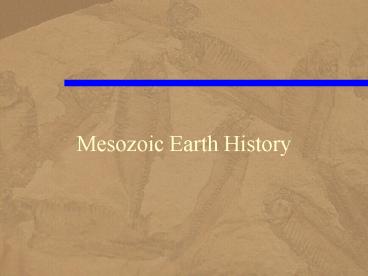Mesozoic Earth History PowerPoint PPT Presentation
1 / 54
Title: Mesozoic Earth History
1
Mesozoic Earth History
2
What is the Mesozoic?
- Middle life after Permian extinction
- 250-66 Ma
- Cretaceous
- Jurassic
- Triassic
3
Geologic Time Scale
www.geo.ucalgary.ca/macrae/timescale/time_scale.g
if
4
Main Happenings in Mesozoic
- Breakup of Pangea
- Lots of mountain-building in western North
America - Appearance of dinosaurs
- Extinction of dinosaurs
5
Effect of the Breakup
- Populations became isolated
- Or were brought into contact with other
populations - Leading to evolutionary changes in the biota
6
www.ig.utexas.edu/research/projects/plates/images/
pangea.jpg
7
Breakup of Pangea 1Opening of North Atlantic
- Began in Late Triassic
- North America and Africa split apart
- North Atlantic Ocean began to open
8
Breakup of Pangea 2Opening of Gulf of Mexico
- In Middle Jurassic, North America and South
America separated - Gulf of Mexico began to open
- Restricted basin at first lots of evaporites
deposited
9
Gulf of Mexico Salt
http//oceanexplorer.noaa.gov/technology/tools/map
ping/media/gis_gulf.html
10
Breakup of Pangea 3Continued Widening of North
Atlantic
- In Late Cretaceous, Atlantic widened rapidly
- Canada and Europe separated
- My thesis topic!
11
Final Breakup
- In Late Cretaceous, Australia and Antarctica
separated - In Cenozoic, Antarctica and South America
separated
12
Global Plate TectonicsJurassic to Present Day
By L.A. Lawver, M.F. Coffin, I.W.D. Dalziel L.M.
Gahagan, D.A. Campbell, and R.M. Schmitz ?2001,
University of Texas Institute for
Geophysics February 9, 2001
13
(No Transcript)
14
(No Transcript)
15
(No Transcript)
16
(No Transcript)
17
(No Transcript)
18
(No Transcript)
19
(No Transcript)
20
(No Transcript)
21
(No Transcript)
22
(No Transcript)
23
(No Transcript)
24
(No Transcript)
25
(No Transcript)
26
(No Transcript)
27
(No Transcript)
28
(No Transcript)
29
(No Transcript)
30
(No Transcript)
31
(No Transcript)
32
(No Transcript)
33
(No Transcript)
34
(No Transcript)
35
Paleogeography of the World
- During the Triassic Period
36
Paleogeography of the World
- During the Jurassic Period
37
Paleogeography of the World
- During the Late Cretaceous Period
38
What does North America look like?
- Still mostly above SL
- Mountain-building on west coast
- Epeiric sea returned to western craton in Middle
Jurassic - Eventually joined Gulf of Mexico to create
continuous seaway from Gulf to Arctic
39
Where did most North American mountain-building
occur during Paleozoic?
40
Where did most North American mountain-building
occur during Paleozoic?
East Coast - Appalachians
41
Cordillera
- Western margin of North America
- Spanish for mountain range
- Rocky Mountains, Sierra Nevadas
42
Cordillera Orogenies
- Nevadan orogeny Late Jurassic/Early Cretaceous
- Sevier orogeny Late Cretaceous
- Laramide orogeny Late Cretaceous/Cenozoic
- Caused mainly by convergent margin tectonics
43
Global Sea-Level Rise
- A global rise in sea level during the Cretaceous
- resulted in worldwide transgressions
- marine deposition was continuous over much of the
North American Cordillera
44
Cretaceous Flood
- Worldwide transgression
- 1/3 of land area of Earth submerged
- 100 Ma
- Cretaceous Interior Seaway in North America
45
Cretaceous Interior Seaway
- Paleogeography of North America during the
Cretaceous Period
46
Western Interior Seaway
www.isgs.uiuc.edu/dinos/westernseaway.gif
47
Western Interior Seaway
www.colorado-mall.com/HTML/EDUCATIONAL/SCIENCES/GE
OLOGY/COLO_GEOLOGY/COLO_CREATION/ANCIENT_SEAS/anci
ent_seas.html
48
What are the 3 main points from todays class?
49
What are the 3 main points from todays class?
- Breakup of Pangea occurred in Mesozoic
- Cordillera began to form through several
orogenies - Cretaceous Interior Seaway formed in North
America
50
The Effects on Global Climates and Ocean
Circulation Patterns
- At the end of the Permian Period
- Pangaea extended from pole to pole
- Covered about one-fourth of Earth's surface
- Surrounded by a global ocean that encompassed
about 300 degrees of longitude - Such a configuration exerted tremendous influence
on the world's climate - resulted in generally arid conditions over large
parts of Pangaea's interior
51
Oceanic Circulation Evolved
- From a simple pattern in a single ocean
(Panthalassa) with a single continent (Pangaea)
52
Oceanic Circulation Evolved
- to a more complex pattern in the newly formed
oceans of the Cretaceous Period
53
Faster Circulation
- The temperature gradient between the tropics and
the poles affects oceanic and atmospheric
circulation - The greater the temperature difference
- the steeper the temperature gradient
- and the faster the circulation of the oceans and
atmosphere
54
Areas Dominated by Seas Are Warmer
- Oceans absorb about 90 of the solar radiation
they receive - continents absorb only about 50
- even less if they are snow covered
- The rest of the solar radiation is reflected back
into space - Therefore, areas dominated by seas are warmer
than those dominated by continents

